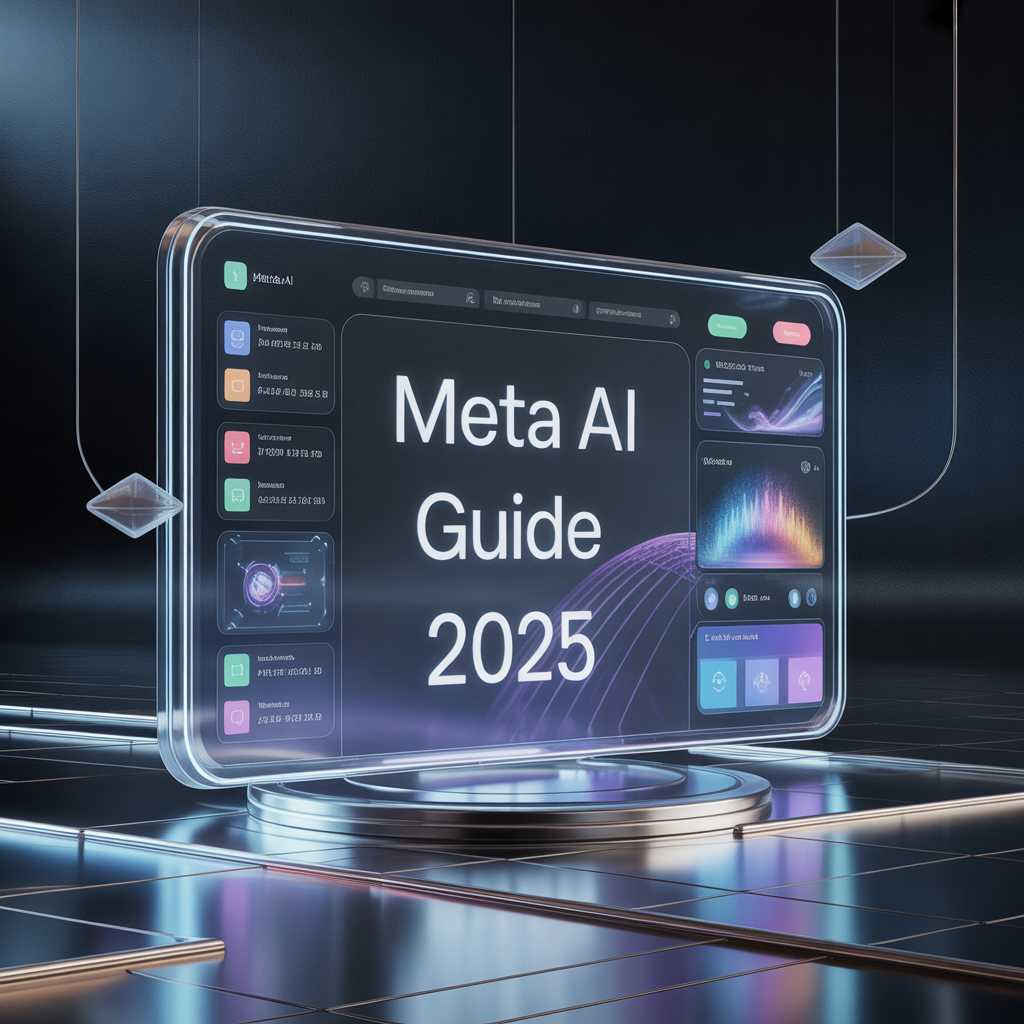Meta AI is quietly reshaping how billions of people interact with technology. It powers the feeds you scroll, the ads you see, and the messages you send across Facebook, Instagram, and WhatsApp. But its influence extends far beyond social media, driving advancements in open-source development, augmented reality, and the ambitious vision of the metaverse. By 2025, understanding Meta AI isn’t just for tech enthusiasts; it’s essential for anyone using its platforms.
From its origins as Facebook AI Research (FAIR) to its current position as a global AI powerhouse, Meta AI has consistently pushed the boundaries of what’s possible. It has given the world foundational tools like the PyTorch machine learning framework and the powerful LLaMA language models, democratizing AI development for researchers and businesses everywhere.
This guide explores the entire Meta AI ecosystem. We will cover its core features, practical applications, and the tools that are defining its future, including the much-anticipated glasses and app.
The Evolution of Meta AI
Meta AI’s journey began long before the company rebranded from Facebook. Its roots are in the 2013 launch of Facebook AI Research (FAIR), a lab dedicated to advancing the science of artificial intelligence. Led by renowned AI pioneer Yann LeCun, FAIR quickly established itself as a leader in deep learning, computer vision, and natural language processing.
A key breakthrough came in 2016 with the release of PyTorch, an open-source machine learning framework. PyTorch simplified the process of building and training neural networks, and its flexibility made it a favorite among researchers. Its adoption fueled a wave of innovation across the AI community and cemented FAIR’s reputation as a collaborative force.
Another major milestone was the introduction of the Large Language Model Meta AI (LLaMA) series. Released to the research community, LLaMA models demonstrated that smaller, more efficient models could achieve state-of-the-art performance. This move challenged the “bigger is better” trend in AI and spurred the development of more accessible and customizable language models.
This move signaled a new focus: applying its foundational research to build the metaverse. Today, Meta AI’s work is central to developing the advanced AR/VR hardware, photorealistic avatars, and seamless digital worlds that form the backbone of Meta’s long-term vision.
Core Features of Meta AI
Meta AI is not a single product but an ecosystem of technologies integrated across the company’s platforms. These features work together to enhance user experiences, empower businesses, and drive new forms of digital interaction.
Generative AI
At the forefront of Meta AI are its generative capabilities. This includes creating text, images, and videos from simple prompts. The Meta AI image generator allows users to create hyper-realistic visuals for everything from social media posts to marketing campaigns. Similar technology is being developed for video and 3D asset creation, which will be crucial for populating the metaverse with rich, dynamic content.
Natural Language Processing (NLP)
NLP is the technology that enables computers to understand and respond to human language. Meta AI uses advanced NLP for:
- Conversational AI: Powering intelligent chatbots and assistants in Messenger and WhatsApp.
- Real-time Translation: Breaking down language barriers in global communications.
- Enhanced Search: Helping users find relevant content and products more intuitively.
Recommendation Systems
The personalized feeds on Facebook and Instagram are driven by some of the most sophisticated recommendation algorithms in the world. The systems analysis user behavior, interests, and connections to deliver content and ads that are highly relevant individual, aiming to increase engagement.
AI in the Metaverse
AI is fundamental to building the metaverse.
- Realistic Avatars: Creating lifelike digital representations of users that can mirror expressions and movements.
- 3D World Generation: Automating the creation of vast, interactive virtual spaces.
- AR/VR Integration: Powering the computer vision and tracking needed for immersive experiences in devices like the Meta AI glasses.
Open-Source Contributions
Meta AI continues to support the global developer community through open-source projects. By sharing tools like PyTorch and models like LLaMA, it accelerates innovation and allows researchers and businesses to build on its foundational work.
Everyday Applications of Meta AI
Meta AI’s technology is already integrated into the daily digital lives of billions. Here’s a look at how it’s applied across Meta’s products and services.
Facebook & Instagram
On Facebook and Instagram, AI is everywhere. It curates the News Feed and Reels, suggesting content it predicts you’ll find engaging. It also plays a critical role in content moderation, automatically detecting and flagging harmful content like hate speech and misinformation. When you tag friends in photos, AI-powered facial recognition is at work.
WhatsApp & Messenger
In messaging apps, Meta AI enables features like smart replies, suggesting quick responses to save you time. Businesses use AI-powered chatbots on these platforms to provide instant customer service, answer frequently asked questions, and even process orders.
Business & Advertising
For businesses, Meta AI is a powerful tool for growth. The ad platform uses machine learning to help advertisers find their ideal audience with remarkable precision. It optimizes ad delivery to maximize conversions and provides analytics that offer deep insights into customer behavior.
The Metaverse
In virtual and augmented reality, AI makes immersive experiences possible. It powers hand tracking on Meta Quest headsets, creates realistic avatars that mimic your facial expressions, and helps build the virtual environments of Horizon Worlds. The upcoming Meta AI glasses will extend these capabilities into the real world.
Developers
Through its open-source initiatives, Meta AI provides developers with the building blocks to create their own AI-powered applications. PyTorch is used by companies and universities worldwide, while LLaMA models serve as a foundation for building custom chatbots, content summarizers, and other language-based tools.
User Concerns: How to Turn Off Meta AI on Facebook
As AI becomes more integrated into social media, many users are asking, How can I turn off Meta AI on Facebook?” The short answer is that you can’t completely disable it. AI is fundamental to how the platform functions, from ranking your feed to moderating content.
However, you can take steps to limit its influence and manage your data.
- Limit Personalization via Ad Settings: Meta AI uses your activity and interests to customize ads across Facebook.
Go to Settings → Ad Preferences in your account.
Review the list of interests Facebook has linked to your profile.
Remove any interests that feel inaccurate or irrelevant to your lifestyle.
Disable options that allow Facebook to show you ads on external websites.
This reduces Meta AI’s personalization power and gives you more ad control. - Hide AI-Generated Posts and Suggestions:Meta AI suggests posts and content you may not always enjoy.
On your feed, click the three-dot menu on unwanted posts.
Select “Hide post” or “Show less” to filter future suggestions.
This feedback trains Meta AI to improve recommendations for you.
While you can’t disable AI content fully, you can influence what appears.
It helps create a feed closer to your real preferences. - Restrict Data Sharing:Meta AI also gathers data from apps and sites you use outside Facebook.
Go to Settings → Off-Facebook Activity to see this activity history.
Review which third-party apps and websites share data with Meta.
Clear the history to remove previously shared information.
Turn off future data sharing to stop new activity being tracked.
This limits Meta AI’s personalization and strengthens your privacy control.
Meta AI Glasses: AI on Your Face
The Meta AI glasses, developed in partnership with Ray-Ban, represent a major step toward bringing AI out of our screens and into the real world. These aren’t just smart glasses; they are an AR-powered wearable designed to be a true personal assistant.
Equipped with a camera, microphones, and speakers, the glasses can see what you see and hear what you hear. This enables a range of powerful AI features:
- Real-Time Translation: Look at a menu in a foreign language and get an instant translation whispered in your ear.
- Object Recognition: Ask the glasses to identify a plant, a landmark, or a breed of dog, and the AI will provide the answer.
- Hands-Free Assistance: You can take calls, send messages, capture photos and videos, and even livestream your point-of-view, all with voice commands.
The Meta AI App and Meta.ai Portal
To centralize its AI experiences, Meta is developing the Meta AI app. This standalone application will serve as a hub for interacting with Meta’s various AI tools and assistants. Users will be able to access the generative AI for creating images and text, manage their AI preferences across platforms, and explore new features as they are released.
Complementing this is the official web portal. This site acts as both a showcase for Meta’s AI research and a resource for developers and businesses. On Meta.ai, you can read about the latest breakthroughs from the research team, download open-source models like LLaMA, and access tools for building with Meta’s technology. It is the public-facing hub for the company’s entire AI ecosystem.
The Meta AI Image Generator
A standout feature within the suite is the Meta AI image generator. Integrated directly into its messaging apps and planned for the standalone app, this tool allows users to create high-quality, realistic images from simple text prompts.
Unlike competitors such as DALL·E 3, Midjourney, and Stable Diffusion, Meta’s key advantage is its deep integration within its ecosystem. A user can generate an image directly in a WhatsApp chat to share with friends or create a custom background for a Facebook post without ever leaving the app. This seamless workflow is designed for mass adoption. The generator is optimized for creating everything from playful memes to polished marketing assets, making it a versatile tool for both casual users and creative professionals.
Meta AI vs. Competitors
The AI landscape is fiercely competitive, with Meta AI facing off against giants like OpenAI (backed by Microsoft) and Google’s DeepMind. Each has distinct strengths and weaknesses.
- OpenAI: Known for its cutting-edge models like GPT-4 and DALL·E 3, OpenAI often leads in raw performance and public buzz. Its partnership with Microsoft gives it massive distribution through products like Bing and Office 365.
- Google DeepMind: With its deep research roots and access to Google’s vast data and computing resources, DeepMind excels at large-scale, complex AI challenges.
Meta AI’s competitive advantages are:
- Unmatched Scale: With over 3 billion daily users across its platforms, Meta has an unparalleled distribution channel and a massive dataset for training its models.
- Open-Source Strategy: By sharing powerful tools like PyTorch and LLaMA, Meta fosters goodwill and innovation, creating an ecosystem that doesn’t solely rely on its own products.
- Metaverse Link: Meta’s focus on AI for AR/VR gives it a unique edge in building the next generation of computing platforms.
However, Meta also faces significant weaknesses, primarily related to public trust. Years of controversies around data privacy and misinformation have createtes regulatory hurdles and a skeptical public, which could slow the adoption.
The Challenges Facing Meta AI
Despite its innovation and scale, Meta AI faces critical challenges that will influence its long-term success and trustworthiness.
Ethical Concerns
Meta AI’s ability to generate highly realistic text, images, and videos raises serious ethical issues. These include the risk of producing harmful content, fueling misinformation, or creating convincing deepfakes. Ensuring AI is used responsibly is a top priority for developers and regulators.
Privacy Risks
Meta AI relies on massive amounts of user data for personalization. This creates concerns about data collection, consent, and usage transparency. With increasing global regulations like GDPR and CCPA, Meta must balance innovation with user privacy and compliance.
Transparency and Accountability
One of the biggest issues is the “black box” problem of AI. Users and even engineers often cannot fully understand how AI models reach decisions. As Meta AI influences critical areas—like ad targeting, recommendations, and content moderation—demand for explainable AI is only growing stronger.
The Future of 2030 Vision
Looking toward 2030, Meta’s vision is for AI to be the invisible fabric connecting all its products and services. The ultimate goal is an AI-powered metaverse, a persistent, shared virtual space where AI agents and human avatars coexist and interact. AI will not only help build this world but will also act as guides, assistants, and companions within it.
For businesses, aims to automate everything from customer service to supply chain management, offering predictive analytics that drive growth. For individuals, the focus is on creating a truly personal AI that understands your context and needs, seamlessly assisting you through devices like the Meta AI glasses.Through its continued commitment to open research, Meta hopes to remain a leader in foundational AI science, shaping the future of the field for decades to come.
An AI Ecosystem in the Making
Meta AI is more than just a collection of features; it is a comprehensive ecosystem designed to redefine our relationship with technology. From enhancing our social media feeds to laying the groundwork for the metaverse, its influence is vast and growing. The journey from FAIR to a globally integrated AI powerhouse demonstrates a clear strategy: to embed AI so deeply into its platforms that it becomes inseparable from the user experience.
Frequently Asked Questions
1. How to turn off Meta AI on Facebook?
You cannot completely turn off as it is integral to Facebook’s core functions. However, you can manage your Ad Settings, hide unwanted AI suggestions, and limit off-Facebook data sharing to reduce its direct influence on your experience.
2. How to get rid of Meta AI from Facebook?
Similar to turning it off, you cannot entirely get rid of Meta AI. Your best option is to use your privacy and ad settings to limit data collection and personalization, giving you more control over the content and ads you see.
3. What is Meta AI used for?
Meta AI is used across Facebook, Instagram, and WhatsApp to power news feeds, recommend content, moderate posts, enable smart replies, and deliver personalized ads. It is also the core technology behind Meta’s metaverse and AR/VR ambitions.
4. What are Meta AI glasses?
The glasses are smart glasses developed with Ray-Ban that integrate AI to provide real-time information.They can translate languages, identify objects, and allow for hands-free calls and photos, all through voice commands.
5. What is the Meta AI app?
The Meta AI app is a planned standalone application that will serve as a central hub for accessing Meta’s various AI tools, including its image generator and conversational assistants, providing a unified experience across platforms.
6. What is Meta.ai?
Meta.ai is the official web portal for Meta’s AI division. It features the latest research news, provides access to open-source models like LLaMA, and offers resources for developers and researchers.
7. Does Meta AI have an image generator?
Yes, Meta AI includes a powerful image generator that can create realistic images from text prompts. It is integrated into Meta’s messaging apps and will be a key feature of the upcoming app.




